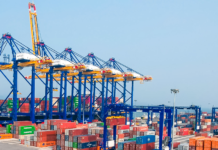
The global shipping industry experienced a significant surge in rates over the past couple of months, as an aftermath of the Red Sea crisis.
Three months into this crisis, container leasing rates on the China-US trade route have surged dramatically, rising by a staggering 223%, or threefold, compared to pre-incident levels. Additionally, container demand is expected to recover in the coming months as the US economy exhibits signs of resilience.
The U.S. economy has exhibited resilience, with GDP rising at a 3.3% annual rate in the
fourth quarter of 2023. This growth was fuelled by gains in consumer spending, non-
residential fixed investment, exports, and government spending, among other factors.
Furthermore, December’s personal income and spending reports reflected lower inflation and solid household spending, contributing to a positive economic outlook.
Despite economic concerns, China is experiencing a surge in demand for ocean container
freight to the United States.
“The gains in consumer spending and retail sales figures suggest that our industry can
expect decent demand recovery for goods, which translates into relatively higher
container demand on the cards, as retailers restock inventory and fulfil consumer orders.”
added Christian Reoloffs, co-founder, and CEO of Container xChange.
According to the Port of Los Angeles’ PortOptimizer, Week 6 TEU volumes were up 38.6%
compared to the same week in 2023 (105,076 TEUs vs. 75,801 TEUs).
One of the industry participants from a global logistics and freight forwarding company
from California, United States shared with Container xChange as part of a response to our
regular polls around container price sentiment, “As attacks on cargo ships in the Middle East continue and vessels are rerouted around southern Africa, we anticipate equipment
shortages due to the lack of container repositioning in Asia for eastbound goods. Furthermore, disruptions in the Suez, Red Sea passage, and Panama Canal will likely lead to increased demand for routing through the West Coast. Many importers are already
rerouting cargo via West Coast transloading and trucking across to the coast, adding
pressure on railways and domestic carriers. We advise all clients to provide advanced
forecasting, considering all routing options proactively, and determining the best course of
action based on cargo readiness dates and required on-site dates.”
Another industry professional, a sales representative at a freight forwarding company in the
US shared, “Our overseas offices have been reporting massive rate spikes, surging almost to COVID crisis levels. I wouldn’t be surprised if those levels are reached by the middle of Q2.”
While the prospects of better container demand in the rest of the year have improved,
shippers are struggling with issues like container crunch in China, and 3X leasing rates on
key trade routes.
The price hike was especially pronounced on routes Ex China to key destinations like New
York, NY and Los Angeles, CA in the United States. (See table below). To gain deeper insights into the cyclical fluctuations of container leasing rates that could have been led by the pre-Chinese New Year surge, we conducted a comparative analysis with last year’s leasing rates in February 2023. Our findings reveal a stark contrast, as the magnitude of the current hike was not observed during the same period in February 2023.

Table 1: Comparison of Container leasing rates (in dollars) Ex China to US East Coast and US
West Coast Trade Routes: November 2023, February 2023, and February 2024 by Container
xChange, an online container logistics platform for container trading and selling
“The significant spikes in shipping rates over the last three months signal a notable shift in
the supply-demand dynamics, with demand recovery and capacity being increasingly tied up as the transit times via the cape of Good Hope increase by 2 –3 weeks. While the pre-
Chinese New Year surge contributed, it was the disruptions caused by the Red Sea rerouting that served as the primary catalyst for the shooting up of leasing rates for containers,” explained Christian Reoloffs, co-founder, and CEO of Container xChange.
Post Chinese New Year Freight rates expectation
“Freight rates were somewhere around $2000 back in February 2023, last year. This year in
2024, these are at US$3392 as of 9 February 2024. These prices last year continued to decline after the Chinese New Year by around 30% until March 2023. If we follow the cyclic trend, then a decline of a similar magnitude in the current freight rates will lead to the prices crashing from US$3393 as of 2 February 2024 to US$2300 in the coming weeks,” shared Christian Reoloffs, cofounder and CEO of Container xChange, an online container logistics platform for container trading and leasing.
On the China to North America east Coast trade route, freight rates doubled between 15
December 2023 to 19 January 2024, (from around US$2500 to roughly US$5000).
Shipping lines and carriers may benefit from higher leasing rates in the short term. However, in the long run, if these elevated costs are maintained, it can increase the cost of exporting goods, potentially squeezing profit margins for manufacturers and exporters. They may need to pass these increased costs onto consumers, leading to higher prices for imported goods.
Container Leasing Rates on China-US Trade Route
The chart below illustrates a sharp increase in leasing rates from China to the West Coast
ports of the United States, particularly Los Angeles and Long Beach, in 2024. In December
2023, prices ranged from US$280 to US$776 for Los Angeles and US$370 to US$710 for Long Beach.
However, prices surged in January 2024, with rates to Los Angeles ranging from US$740 to
US$920 and to Long Beach from US$700 to US$920. This trend continued into February 2024, with rates to Los Angeles reaching US$1070 to US$1230.


Prices for shipping containers from China to New York and Savannah, GA ranged from US$400 to US$820 and US$590 to US$1043, respectively, from September to December 2023. In January, prices rose notably, with rates to New York ranging from US$608 to US$1008 and to Savannah from US$706 to US$733. Prices continued to rise in February, with rates to New York reaching US$1290 to US$1730.
China to New York rates more than doubled from December 2023 to February 2024, while
rates for shipping containers to Los Angeles increased by nearly US$435 during the same
period.
This article was written by Container xChange, a global online platform facilitating container leasing and trading, connecting container users with owners.





